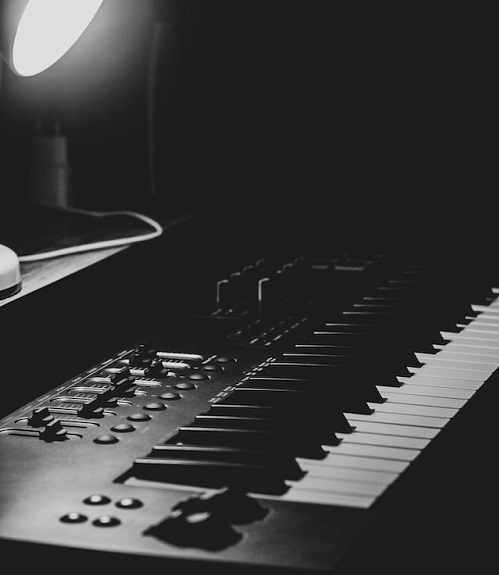In order to assign sounds and samples to a MIDI keyboard, you must first learn how a sampler functions. A sampler is a device that allows users to record, edit, and playback digital audio. Typically. samplers have built-in memory that stores the recorded audio, as well as various effects that can be applied to the recording. Many samplers also have the ability to connect to other devices, such as computers or synthesizers, which allows for even more flexibility when creating music.
After you learn how to navigate around samplers, you can start assigning and creating your own custom sounds, which can be used in a variety of different ways. You can also use samples to create new drum patterns or loops, which can add a lot of creativity to your music.
A MIDI Keyboard is a type of electronic keyboard that uses the Musical Instrument Digital Interface protocol to send and receive signal information. A MIDI Keyboard needs a sampler to assign sounds and samples. The sampler enables the keyboard to play back pre-recorded or user-created sounds and samples. Did you know that you can program your keys to play a drum roll, flute note, or even a cartoonish voice? how cool is that! Additionally, If you want to create your own sounds and samples, you can record them yourself. Or, if you prefer, you can use ones that others have recorded. Either way, you'll have a wide range of options to choose from.
The internet has countless recordings that can be accessed for free. These recordings are referred to as samples. First, you'll need to load a sample into your MIDI keyboard. To do this, simply select the "load" option on your keyboard's interface. Once the sample is loaded, you can start mapping it out according to which keys on your keyboard correspond to which notes in the sample. This way, you can play the sample back in any order or key that you like!
Multi-sampling is a recording technique that involves capturing the entire sound of an instrument, as well as the nuances and subtleties that come with it. This allows for a much more lifelike and realistic sound when the instrument is played back, as opposed to simply recording the sound with a MIDI keyboard. This process can be quite time-consuming and often requires a lot of patience and effort to complete. One thing to keep in mind is, it will sound artificial if you're too far away from the actual pitch.
To ensure that the sampler patches are as close to the original pitch as possible, you need to map them to keys that are closer to the original pitch. This way, you can accurately recreate the sounds of an instrument.
How Does a Sampler Work?
Analog signals are constantly changing, which means they are the basis of sound waves. This is because sound waves are created when air molecules vibrate and create pressure changes. These pressure changes cause the air molecules to bump into each other and create sound waves. On the contrary, computers can only process electronic data which consists of zeros and ones. This means that they are limited in their ability to understand and process information that is not in this format.
Analog to digital converters, or ADCs, are devices that convert analog sounds into digital waves. Analog sounds are those that exist in the real world, like the sound of a person speaking or the sound of a guitar being played. Digital waves, on the other hand, are a series of 1s and 0s that can be read by computers and other electronic devices. The ADC measures the amplitude of the incoming sound signal and divides it into small sections. Each section is then assigned a number based on its intensity. This allows for a more accurate representation of the original sound.
A sample is a small portion of an audio file that is used to represent the entire file. The process of converting an audio file into different sections is called sampling. Sampling allows for a more accurate representation of the original audio file, as well as more flexibility in terms of editing and manipulating the sound. A sampler records sound by converting the physical waveform of the sound into a digital code. This code is then stored in the sampler's memory.
The sound file is parsed by splitting the stream into separate, sequential data packets and assigning a numerical value to each packet, representing its loudness. The sound then has its intensity distributed back in time by recombining the packets in their correct order with an analog converter.
Assigning Sounds and Samples to a MIDI Keyboard
Find Sound Samples
To find free and legal sound samples, the first step is to search for websites that offer them. Once you've found a few good options, take some time to explore each one and see what kinds of sounds they have available. If you're looking for specific types of sounds, make sure to check out the tags or categories so you can narrow down your search. Once you've found a few sounds that you like, download them and save them to your computer so you can use them in your project.
These are a few websites you can use to find samples:
- Absolute Sound Effects Archive
- ccMixter
- SoundBible
- The Freesound Project
Recording your own sample can be difficult at first, so we recommend starting with a pre-recorded one. This will give you time to learn how to properly record a sample. It may be helpful to download the files in a .aif or .wav format. In order to get the best results, we recommend downloading two files. This way, you will have a backup if one file does not work.
Editing the Sound File
After recording the sound file, the next step is to edit it to ensure that the sampling is correct. This process involves checking the levels and adjusting them as necessary, as well as ensuring that there is no background noise or other interference that could affect the quality of the recording. By taking these steps, you can be sure that your recording is of the highest possible quality.
Programming
There are different kinds of samplers on the market. You can find hardware samplers, which are physical devices that you can touch and interact with. Alternatively, there are software samplers, which are programs that you run on your computer. Both options have their own benefits and drawbacks, so it's important to choose the right type of sampler for your needs. Some of the most popular digital audio workstations are Apple’s Logic, Propellerhead’s Reason and Ableton’s Live. These three software packages offer a wide range of features and options to suit the needs of any musician or producer.
Parting Notes
To be able to assign sounds and samples to a MIDI keyboard effectively, you need to be extremely organized. This means having a clear idea of what kind of sounds you want and where they should go. You also need to be able to keep track of all the different parts of your keyboard so that you can easily find the sound you're looking for when you need it. Although it may be a tedious task, you can end up with lots of musical samples if you are willing to put in the time. This can be a great way to find new music that you enjoy, and it can also help you expand your musical knowledge.
With so many options out there, it is definitely worth taking the time to explore all of the different possibilities. Are you ready to give it a try?
Harlan Kilstein began playing piano during covid with no piano background at all. He taught himself how to play learning what to do and what not to do.
Today he's an advanced intermediate player and can help you grow in your skills because he learned all this on his own.








